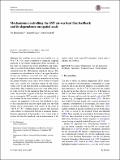| dc.contributor.author | Czaja, Arnaud | |
| dc.contributor.author | Hausmann, Ute | |
| dc.contributor.author | Marshall, John C | |
| dc.date.accessioned | 2017-03-10T18:35:51Z | |
| dc.date.available | 2017-03-10T18:35:51Z | |
| dc.date.issued | 2016-05 | |
| dc.date.submitted | 2015-12 | |
| dc.identifier.issn | 0930-7575 | |
| dc.identifier.issn | 1432-0894 | |
| dc.identifier.uri | http://hdl.handle.net/1721.1/107385 | |
| dc.description.abstract | The turbulent air-sea heat flux feedback (α, in W m[superscript −2] K[superscript −1]) is a major contributor to setting the damping timescale of sea surface temperature (SST) anomalies. In this study we compare the spatial distribution and magnitude of αα in the North Atlantic and the Southern Ocean, as estimated from the ERA-Interim reanalysis dataset. The comparison is rationalized in terms of an upper bound on the heat flux feedback, associated with “fast” atmospheric export of temperature and moisture anomalies away from the marine boundary layer, and a lower bound associated with “slow” export. It is found that regions of cold surface waters (≤10 ∘C) are best described as approaching the slow export limit. This conclusion is not only valid at the synoptic scale resolved by the reanalysis data, but also on basin scales. In particular, it applies to the heat flux feedback acting as circumpolar SST anomaly scales are approached in the Southern Ocean, with feedbacks of ≤10 W m[superscript −2] K[superscript −1]. In contrast, the magnitude of the heat flux feedback is close to that expected from the fast export limit over the Gulf Stream and its recirculation with values on the order of ≈40 W m[superscript −2] K[superscript −1]. Further analysis suggests that this high value reflects a compensation between a moderate thermodynamic adjustment of the boundary layer, which tends to weaken the heat flux feedback, and an enhancement of the surface winds over warm SST anomalies, which tend to enhance the feedback. | en_US |
| dc.description.sponsorship | National Science Foundation (U.S.). Frontiers in Earth System Dynamics | en_US |
| dc.publisher | Springer Berlin Heidelberg | en_US |
| dc.relation.isversionof | http://dx.doi.org/10.1007/s00382-016-3142-3 | en_US |
| dc.rights | Creative Commons Attribution-Noncommercial-Share Alike | en_US |
| dc.rights.uri | http://creativecommons.org/licenses/by-nc-sa/4.0/ | en_US |
| dc.source | Springer Berlin Heidelberg | en_US |
| dc.title | Mechanisms controlling the SST air-sea heat flux feedback and its dependence on spatial scale | en_US |
| dc.type | Article | en_US |
| dc.identifier.citation | Hausmann, Ute, Arnaud Czaja, and John Marshall. “Mechanisms Controlling the SST Air-Sea Heat Flux Feedback and Its Dependence on Spatial Scale.” Climate Dynamics 48, no. 3–4 (May 4, 2016): 1297–1307. | en_US |
| dc.contributor.department | Massachusetts Institute of Technology. Department of Earth, Atmospheric, and Planetary Sciences | en_US |
| dc.contributor.mitauthor | Hausmann, Ute | |
| dc.contributor.mitauthor | Marshall, John C | |
| dc.relation.journal | Climate Dynamics | en_US |
| dc.eprint.version | Author's final manuscript | en_US |
| dc.type.uri | http://purl.org/eprint/type/JournalArticle | en_US |
| eprint.status | http://purl.org/eprint/status/PeerReviewed | en_US |
| dc.date.updated | 2017-02-02T15:20:18Z | |
| dc.language.rfc3066 | en | |
| dc.rights.holder | Springer-Verlag Berlin Heidelberg | |
| dspace.orderedauthors | Hausmann, Ute; Czaja, Arnaud; Marshall, John | en_US |
| dspace.embargo.terms | N | en |
| dc.identifier.orcid | https://orcid.org/0000-0002-8195-5938 | |
| dc.identifier.orcid | https://orcid.org/0000-0001-9230-3591 | |
| mit.license | OPEN_ACCESS_POLICY | en_US |
